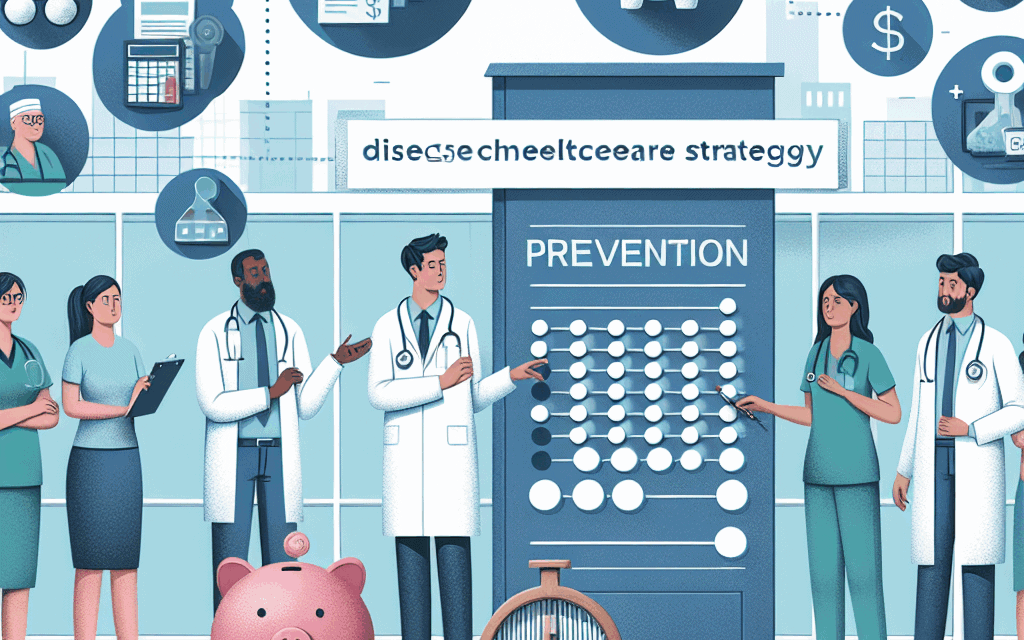CMMI Shifts Strategy Towards Disease Prevention and Cost Efficiency
The healthcare landscape is undergoing a significant transformation, driven by the need for improved patient outcomes and cost management. The Capability Maturity Model Integration (CMMI) has emerged as a pivotal framework in this evolution, focusing on enhancing healthcare delivery through disease prevention and cost efficiency. This article delves into the strategic shift of CMMI, exploring its implications, methodologies, and real-world applications in the healthcare sector.
Understanding CMMI: A Framework for Improvement
The Capability Maturity Model Integration (CMMI) is a process improvement framework that provides organizations with essential elements for effective process improvement. Originally developed for software engineering, CMMI has been adapted for various sectors, including healthcare. The model emphasizes continuous improvement, enabling organizations to enhance their processes, products, and services.
CMMI is structured into five maturity levels:
- Initial: Processes are unpredictable and reactive.
- Managed: Processes are planned and executed in accordance with policy.
- Defined: Processes are well characterized and understood.
- Quantitatively Managed: Processes are controlled using statistical and other quantitative techniques.
- Optimizing: Focus on continuous process improvement.
In the context of healthcare, CMMI provides a structured approach to improving patient care, reducing costs, and enhancing operational efficiency. The model encourages organizations to assess their current processes, identify areas for improvement, and implement strategies that lead to better health outcomes.
The Shift Towards Disease Prevention
One of the most significant shifts in healthcare strategy is the focus on disease prevention rather than treatment. This proactive approach aims to reduce the incidence of diseases, thereby lowering healthcare costs and improving quality of life. CMMI plays a crucial role in this transition by providing a framework for organizations to implement preventive measures effectively.
Preventive healthcare encompasses a range of strategies, including:
- Screening and Early Detection: Regular screenings for conditions such as diabetes, hypertension, and cancer can lead to early intervention and better outcomes.
- Vaccination Programs: Immunization against infectious diseases is a cornerstone of preventive healthcare, significantly reducing morbidity and mortality rates.
- Health Education: Educating patients about lifestyle choices, nutrition, and exercise can empower them to take charge of their health.
- Chronic Disease Management: Programs that focus on managing chronic conditions can prevent complications and reduce hospitalizations.
For instance, the CMMI’s Accountable Care Organization (ACO) model incentivizes healthcare providers to focus on preventive care. ACOs are designed to improve care coordination and reduce unnecessary spending by emphasizing preventive services. According to a report by the Centers for Medicare & Medicaid Services (CMS), ACOs have successfully reduced hospital admissions and emergency room visits, demonstrating the effectiveness of preventive strategies.
Moreover, the integration of technology in preventive care has been transformative. Telehealth services, wearable health devices, and mobile health applications enable patients to monitor their health proactively. These tools not only facilitate early detection of health issues but also encourage patients to engage in preventive behaviors.
Cost Efficiency in Healthcare Delivery
As healthcare costs continue to rise, the need for cost efficiency has become paramount. CMMI’s focus on process improvement directly contributes to cost reduction by streamlining operations and eliminating waste. By adopting CMMI practices, healthcare organizations can achieve significant savings while maintaining high-quality care.
Cost efficiency can be achieved through various strategies:
- Process Standardization: Standardizing procedures reduces variability and improves efficiency. For example, implementing standardized protocols for patient admissions can decrease wait times and enhance patient flow.
- Data-Driven Decision Making: Utilizing data analytics allows organizations to identify trends, allocate resources effectively, and make informed decisions that lead to cost savings.
- Lean Methodologies: Lean principles focus on eliminating waste and optimizing processes. Healthcare organizations that adopt lean practices can reduce costs while improving patient care.
- Value-Based Care: Transitioning from fee-for-service to value-based care models incentivizes providers to deliver high-quality care at lower costs.
A case study highlighting the impact of CMMI on cost efficiency is the Virginia Mason Medical Center in Seattle. By implementing lean methodologies and CMMI principles, the center reduced its operating costs by 30% while improving patient satisfaction scores. This transformation demonstrates how a focus on process improvement can lead to substantial financial benefits.
Furthermore, the integration of technology plays a crucial role in enhancing cost efficiency. Electronic health records (EHRs), for instance, streamline documentation processes, reduce administrative burdens, and improve communication among healthcare providers. By minimizing errors and redundancies, EHRs contribute to overall cost savings in healthcare delivery.
Case Studies: Successful Implementation of CMMI in Healthcare
Numerous healthcare organizations have successfully implemented CMMI principles to enhance disease prevention and cost efficiency. These case studies provide valuable insights into the practical applications of the framework and its impact on healthcare delivery.
One notable example is the Geisinger Health System in Pennsylvania. Geisinger adopted CMMI’s patient-centered medical home (PCMH) model, which emphasizes coordinated care and preventive services. As a result, Geisinger reported a 20% reduction in hospital admissions and a 7% decrease in overall healthcare costs. The success of this model highlights the effectiveness of CMMI in promoting preventive care and improving patient outcomes.
Another compelling case is the implementation of CMMI principles at the University of Michigan Health System. The organization focused on reducing hospital-acquired infections (HAIs) through standardized protocols and continuous monitoring. By adopting evidence-based practices and engaging staff in quality improvement initiatives, the health system achieved a 50% reduction in HAIs over three years. This case underscores the importance of process improvement in enhancing patient safety and reducing healthcare costs.
Additionally, the Massachusetts General Hospital implemented CMMI’s value-based care model to improve care coordination for patients with chronic conditions. By integrating behavioral health services and enhancing communication among providers, the hospital reduced emergency room visits by 30% and improved patient satisfaction scores. This example illustrates how CMMI can facilitate a holistic approach to patient care, ultimately leading to better health outcomes and cost savings.
The Role of Technology in CMMI Implementation
Technology plays a pivotal role in the successful implementation of CMMI principles in healthcare. The integration of advanced technologies enhances data collection, analysis, and communication, enabling organizations to improve processes and outcomes effectively.
Key technological advancements that support CMMI implementation include:
- Telemedicine: Telehealth services allow patients to access care remotely, reducing barriers to treatment and promoting preventive care. This technology has gained significant traction, especially during the COVID-19 pandemic, as it enables healthcare providers to reach patients in their homes.
- Data Analytics: Advanced analytics tools enable healthcare organizations to analyze large datasets, identify trends, and make data-driven decisions. Predictive analytics can help identify high-risk patients, allowing for targeted interventions that prevent disease progression.
- Wearable Devices: Wearable health technology, such as fitness trackers and smartwatches, empowers patients to monitor their health metrics actively. These devices can provide valuable data to healthcare providers, facilitating early intervention and personalized care.
- Artificial Intelligence (AI): AI applications in healthcare can enhance diagnostic accuracy, streamline administrative processes, and improve patient engagement. For example, AI algorithms can analyze medical images to detect abnormalities, leading to earlier diagnosis and treatment.
The integration of these technologies not only supports CMMI’s focus on process improvement but also enhances patient engagement and satisfaction. For instance, a study published in the Journal of Medical Internet Research found that patients who used telehealth services reported higher satisfaction levels and improved health outcomes compared to those who did not.
Moreover, the use of technology in healthcare can lead to significant cost savings. A report by the American Hospital Association estimated that telehealth could save the U.S. healthcare system up to $4.28 billion annually by reducing unnecessary emergency room visits and hospitalizations.
Conclusion: The Future of CMMI in Healthcare
The shift towards disease prevention and cost efficiency through the CMMI framework represents a transformative approach to healthcare delivery. By emphasizing process improvement, organizations can enhance patient outcomes, reduce costs, and promote a culture of continuous improvement.
As healthcare continues to evolve, the integration of technology will play a crucial role in supporting CMMI implementation. Telehealth, data analytics, and AI are just a few examples of how technology can enhance preventive care and streamline operations.
In summary, the strategic shift of CMMI towards disease prevention and cost efficiency is not just a trend; it is a necessary evolution in healthcare. By adopting CMMI principles, organizations can position themselves for success in an increasingly complex and demanding healthcare environment. The future of healthcare lies in proactive, patient-centered approaches that prioritize prevention and efficiency, ultimately leading to better health outcomes for all.




